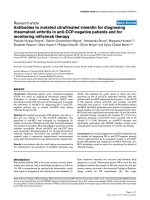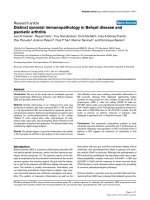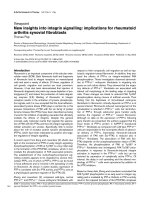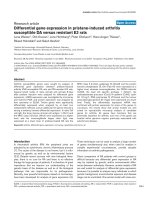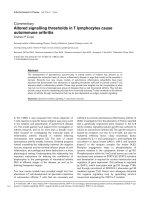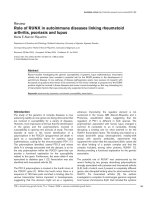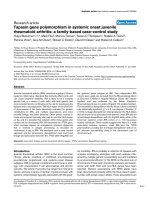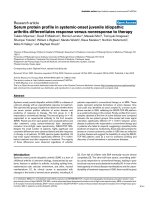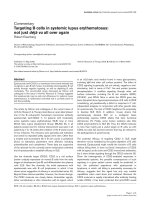Báo cáo y học: "Tapasin gene polymorphism in systemic onset juvenile rheumatoid arthritis: a family-based case–control study" pot
Bạn đang xem bản rút gọn của tài liệu. Xem và tải ngay bản đầy đủ của tài liệu tại đây (133.14 KB, 6 trang )
Open Access
Available online />R285
Vol 7 No 2
Research article
Tapasin gene polymorphism in systemic onset juvenile
rheumatoid arthritis: a family-based case–control study
Hulya Bukulmez
1,2,3,4
, Mark Fife
5
, Monica Tsoras
1
, Susan D Thompson
1
, Natalie A Twine
5
,
Patricia Woo
5
, Jane M Olson
2
, Robert C Elston
2
, David N Glass
1
and Robert A Colbert
1
1
William S. Rowe Division of Pediatric Rheumatology, Cincinnati Children's Hospital Medical Center, University of Cincinnati, Cincinnati, Ohio, USA
2
Department of Epidemiology and Biostatistics, Case Western Reserve University, Cleveland, Ohio, USA
3
Department of Genetics, Case Western Reserve University, Cleveland, Ohio, USA
4
Pediatric Rheumatology, Pediatrics, Metro Health Medical Center, Case Western Reserve University, Cleveland, Ohio, USA
5
The Center for Pediatric and Adolescent Rheumatology, University College London, London, UK
Corresponding author: Hulya Bukulmez,
Received: 13 Mar 2004 Revisions requested: 13 May 2004 Revisions received: 17 Nov 2004 Accepted: 22 Nov 2004 Published: 11 Jan 2005
Arthritis Res Ther 2005, 7:R285-R290 (DOI 10.1186/ar1480)
http://arthr itis-research.com/conte nt/7/2/R285
© 2005 Bukulmez et al., licensee BioMed Central Ltd.
This is an Open Access article distributed under the terms of the Creative Commons Attribution License ( />2.0), which permits unrestricted use, distribution, and reproduction in any medium, provided the original work is cited.
Abstract
Juvenile rheumatoid arthritis (JRA) comprises a group of chronic
systemic inflammatory disorders that primarily affect joints and
can cause long-term disability. JRA is likely to be a complex
genetic trait, or a series of such traits, with both genetic and
environmental factors contributing to the risk for developing the
disease and to its progression. The HLA region on the short arm
of chromosome 6 has been intensively evaluated for genetic
contributors to JRA, and multiple associations, and more
recently linkage, has been detected. Other genes involved in
innate and acquired immunity also map to near the HLA cluster
on 6p, and it is possible that variation within these genes also
confers risk for developing JRA. We examined the TPSN gene,
which encodes tapasin, an endoplasmic reticulum chaperone
that is involved in antigen processing, to elucidate its
involvement, if any, in JRA. We employed both a case–control
approach and the transmission disequilibrium test, and found
linkage and association between the TPSN allele (Arg260) and
the systemic onset subtype of JRA. Two independent JRA
cohorts were used, one recruited from the Rheumatology Clinic
at Cincinnati Children's Hospital Medical Center (82 simplex
families) and one collected by the British Paediatric
Rheumatology Group in London, England (74 simplex families).
The transmission disequilibrium test for these cohorts combined
was statistically significant (χ
2
= 4.2, one degree of freedom; P
= 0.04). Linkage disequilibrium testing between the HLA alleles
that are known to be associated with systemic onset JRA did not
reveal linkage disequilibrium with the Arg260 allele, either in the
Cincinnati systemic onset JRA cohort or in 113 Caucasian
healthy individuals. These results suggest that there is a weak
association between systemic onset JRA and the TPSN
polymorphism, possibly due to linkage disequilibrium with an as
yet unknown susceptibility allele in the centromeric part of
chromosome 6.
Keywords: association, linkage, juvenile rheumatoid arthritis, tapasin, TPSN, transmission disequilibrium testing
Introduction
Juvenile rheumatoid arthritis (JRA) is the most common
chronic arthritic condition of childhood, encompassing
pauciarticular, polyarticular, and systemic-onset disease
subtypes. JRA is typically considered autoimmune in etiol-
ogy, with characteristic T-cell abnormalities and chronic
synovitis. The extent of synovitis may range from minimal to
severe, and vary in terms of number of joints involved, with
systemic onset disease typically associated with the great-
est morbidity. JRA is probably a collection of diseases with
complex overlapping etiologies, with each subtype influ-
enced by multiple genetic susceptibility loci and mediated
by environmental effects [1]. The MHC on the short arm of
chromosome 6 has been intensively analyzed, and associ-
ations with both HLA and non-HLA genes have been
reported. Genetic associations with MHC alleles have
been documented primarily within the HLA class II region,
but also with certain class I alleles. These associations are
df = degrees of freedom; IL = interleukin; JRA = juvenile rheumatoid arthritis; LD = linkage disequilibrium; MHC = major histocompatibility complex;
PDT = pedigree disequilibrium test; SoJRA = systemic onset juvenile rheumatoid arthritis; TDT = transmission disequilibrium test; TNF = tumor necro-
sis factor.
Arthritis Research & Therapy Vol 7 No 2 Bukulmez et al.
R286
largely JRA subtype and age specific [2], and are strongest
for pauciarticular and polyarticular disease [1]. For sys-
temic onset JRA (SoJRA), associations with HLA-B8, HLA-
Bw35 [3,4] and HLA-DR4 [3,5] have been observed,
whereas HLA-DPB1*0401 was reported to have a protec-
tive effect in one Caucasian population [6]. Associations
with HLA-DRB1*0401 and HLA-DRB1*0405 have been
reported in a Japanese population [7]. Most of these asso-
ciations have not been replicated.
In the present study we targeted the tapasin gene (TPSN),
which is in the class II region of the MHC, 180 kilobases
centromeric of HLA-DP. The tapasin protein is necessary
for the proper assembly and peptide-presenting function of
HLA class I molecules [8]. The TPSN gene has a polymor-
phism in exon 4 that results in a nonconservative amino
acid substitution of Arg/Thr at amino acid 260 (ref SNP ID:
rs2071888) [9,10]. Three intronic polymorphisms of TPSN
have also been described, none of which appear to be in
linkage disequilibrium (LD) with HLA class I alleles or the
extended HLA-A1, HLA-B8, HLA-DR3 haplotype, in at
least one healthy Caucasian population [11]. Furthermore,
using a large UK Caucasian sample, Ahmad and coworkers
[12] recently reported that TPSN polymorphisms are not in
LD with more telomeric MHC haplotypes. In the present
study we report an association between the exon 4 TPSN
polymorphism and susceptibility to SoJRA, involving the
TPSN allele Arg260 (01 allele).
Methods
The study cohort included 88 SoJRA affected families
recruited in Cincinnati (US cohort) and 74 simplex (with
one affected offspring) SoJRA families identified by the
British Paediatric Rheumatology Study Group (UK cohort).
Unaffected siblings were available for analysis in the US
but not in the UK cohort. An additional 113 healthy unre-
lated control individuals, primarily Caucasians from the Mid-
west and New England, resembled the SoJRA-affected
families in terms ethnicity and served as the control popu-
lation. Ethics approvals were obtained from the participat-
ing institutions, and informed consent was obtained from
parents and/or children.
All affected children met American College of Rheumatol-
ogy criteria for a diagnosis of JRA; they were subgrouped
as pauciarticular, polyarticular, or SoJRA. Genomic DNA
was purified from peripheral blood cells by standard tech-
niques and analyzed for TPSN alleles (Arg260/01 and
Thr260/02) by polymerase chain reaction and restriction
site enzyme digestion. Briefly, a 298-base-pair fragment of
exon 4 of the TPSN gene containing the polymorphism was
amplified and then digested with BfaI, which recognizes
the 01 allele, and SfcI, which recognizes the 02 allele. The
primers used were Tsn 479 forward (5'-CCC ACC CTC
TAC CCC TGG A-3') and Tsn 641 reverse (5'-CAG CAC
CTG GGT AAG GGA CA-3'). HLA types were determined
for a subgroup of the participants using DNA-based low-
resolution methodology (Geno-Vision Inc., Exton, PA,
USA), and serologically using standard typing sera and
microcytotoxicity assays.
Preliminary association analysis was conducted by χ
2
test-
ing on contingency tables comparing the three genotypic
frequencies between cases and control individuals to yield
a χ
2
with two degrees of freedom. Family-based associa-
tion analysis was performed using the transmission disequi-
librium test (TDT). The TDT [13,14] is a family-based
association test that compares within a cohort the number
of times a particular parental allele is transmitted to an
affected offspring versus the number of times it is not trans-
mitted. To allow inclusion of families with missing data for a
single parent, the Transmit program http://www-
gene.cimr.cam.ac.uk/clayton/software/[15], which uses
population allele frequencies to weight the possible paren-
tal genotypes, was used for the TDT analysis. In the Trans-
mit program, genotypes of unaffected siblings (or siblings
whose disease status is unknown) are used to infer paren-
tal genotypes, thus increasing the power to detect associ-
ation. We applied this test first to the combined US and the
UK data and then to each set separately. The significance
level of the combined results was also calculated using
Fisher's method of combining P values for two independent
analyses that test the same hypothesis. LD between TPSN
and the HLA region (limited to the Cincinnati cohort) was
evaluated using the EH program kefel
ler.edu/ott/eh.htm[16,17]. The Geno-Pdt test in the PdT
5.1 program />pdt.html was also used as a test for association and linkage
in the US SoJRA-affected families [18-20].
Results
The distribution of tapasin genotypes among SoJRA-
affected children was compared with that in their healthy
siblings, as well as with that in unrelated healthy control
individuals using a two degrees of freedom χ
2
test in the US
cohort (Table 1). The differences did not reach statistical
significance. The allelic frequencies of tapasin in the inde-
pendent cohorts from the USA (Table 1) were in Hardy–
Weinberg equilibrium (healthy individuals from the USA: χ
2
= 0.3049, P = 0.58; SoJRA-affected individuals from the
USA: χ
2
= 2.004, P = 0.156). In the UK data only SoJRA-
affected individuals were available for Hardy–Weinberg
equilibrium testing, and the result was borderline (χ
2
=
5.26, P = 0.02).
We then tested for evidence of linkage of TPSN to JRA by
applying the family-based TDT only to the cohorts of
affected individuals for whom parental and sibling informa-
tion was available. These families included 82 US SoJRA
familes (389 individuals, including family members) and 74
Available online />R287
UK SoJRA families. The TDT test, as implemented in the
Transmit program, detected the preferential transmission of
the TPSN 01 allele in the UK and US SoJRA families (n =
156; χ
2
= 4.2, 1 degree of freedom [df]; P = 0.04; Table 2).
When the US SoJRA cohort was analyzed alone, this pref-
erential transmission for the TPSN allele 01 was even more
significant (χ
2
= 6.0, 1 df; P = 0.01; Table 2).
However, SoJRA families from the UK alone as a subgroup
failed to show significant preference for TPSN allele 01
transmission (χ
2
= 0.075, 1 df; P = 0.78; Table 2). When
the SoJRA UK cohort was analyzed, it was recognized that
information for one of the parents was missing in 22 fami-
lies (29.7% of the total). There was no information from
unaffected siblings of the probands for these UK families,
which is necessary for the Transmit program to narrow
down the range of the possible parental genotypes. When
one parent is missing, the Transmit program assigns and
weights possible haplotypes to the missing parent using
the information from the known parent and the siblings of
the proband, and averages the probability of all transmis-
sions to the proband. Because there were no data regard-
ing the genotypes of unaffected siblings for the UK families,
the Transmit program was unable to infer parental geno-
types and thus had less power to detect the preferential
transmission of the 260Arg allele. In the US SoJRA-
affected cohort parental information was missing for 32 of
the 82 families (39%), but for 12 of these (14.6%) there
was information regarding unaffected siblings. Although
24.4% of the cohort was unavailable for TDT calculation,
62 families (75.6%) were available.
We combined the two P values using Fisher's method [21]
to obtain a χ
2
with four degrees of freedom and found the
combination of the two analyses to be significant (χ
2
= 9.7,
4 df; P = 0.05). Overall, when the two cohorts were ana-
lyzed together the tapasin 260Arg allele was transmitted
more often than the 260Thr allele, suggesting association
and linkage between the TPSN polymorphism and SoJRA.
In order to include information from the unaffected siblings
for association testing, we also applied an alternative asso-
ciation test to the US SoJRA population – the pedigree dis-
equilibrium test (PDT) [18,19]. A new version of PDT, the
genotype-based association test for pedigrees (Genotype-
PDT), was applied to the data. Genotype-PDT [20] tests for
linkage and underlying patterns of association at the geno-
typic level. It is more conservative and has lesser type 1
error when compared with the TDT test implemented in the
Transmit program. Genotype-PDT also uses information
from affected individuals, unaffected siblings, and their
nuclear families. Therefore, we were only able to apply this
test to the US SoJRA cohort. The genotype-PDT test
revealed association and linkage of the tapasin 260Arg
Table 1
Tapasin genotypic distributions in systemic onset juvenile rheumatoid arthritis families
Tapasin genotypes US healthy control
individuals
US healthy siblings of
SoJRA
US SoJRA UK SoJRA UK and US SoJRA
0101 35 (31.0%) 26 (28.0%) 49 (36.6%) 23 (30.0%) 72 (34.4%)
0102 56 (49.5%) 50 (53.7%) 63 (47.0%) 45 (60.0%) 108 (51.6%)
0202 22 (19.5%) 17 (18.3%) 22 (16.4%) 7 (9.2%) 29 (14.0%)
01 allele frequency 0.56 0.55 0.6 0.6 0.6
02 allele frequency 0.44 0.45 0.4 0.4 0.4
Total 113 93 134 76 209
Tapasin 01 allele is Arg260, and 02 is Thr260. SoJRA, systemic onset juvenile rheumatoid arthritis.
Table 2
Transmission disequilibrium test analysis of the US and UK systemic onset juvenile rheumatoid arthritis families using Transmit
Arg260 transmission Thr260 transmission
SoJRA families n Observed Expected Observed Expected χ
2
(1 df) P
US only 82 99 (88.0) 65 (75.9) 6.0* 0.01*
US unaffected siblings 79 82 (77.5) 76 (80.5) 1.04 0.3
UK only 74 91 (89.0) 57 (58.0) 0.08 0.78
UK and US together 156 190 (177.8) 122 (134.2) 4.2* 0.04*
*Significant findings. n, number of informative families for transmission; UK, British Paediatric Rheumatology Study Group cohort; US, Cincinnati
cohort.
Arthritis Research & Therapy Vol 7 No 2 Bukulmez et al.
R288
allele with SoJRA at the genotypic level (χ
2
= 6.727, 1 df;
P = 0.034) in the US SoJRA cohort.
Furthermore, we wished to control for possible transmis-
sion distortion of tapasin 260Arg allele in SoJRA-affected
families. This allele could also be preferentially transmitted
to the unaffected siblings of the SoJRA-affected individuals
from their parents, and our statistical significance could be
falsely inflated because of allele-specific segregation bias
(altered transmission of an allele independent of its role in
disease). We therefore applied the TDT test to the unaf-
fected siblings from the US SoJRA cohort. In contrast to
the affected siblings, there was no significant preference
toward 260Arg allele transmission to healthy siblings, sug-
gesting no segregation bias (χ
2
= 1.043, 1 df; P = 0.3;
Table 2). These data provide evidence of a genotypic asso-
ciation and linkage between the TPSN 260Arg allele and
susceptibility to SoJRA.
Discussion
Although JRA is the most common rheumatologic disease
in childhood, the SoJRA subtype comprises less then 20%
of cases and is a rare disease. In the past, because of the
small sample sizes, studies conducted by single centers
failed to establish strong genetic associations. The present
study was therefore done with collaboration between two
different centers. These two centers recruited mainly Cau-
casian families with one SoJRA-affected offspring. An
association of the TPSN allele 260Arg with SoJRA was
detected when both cohorts were analyzed and in the US
cohort by itself. In the UK cohort the statistical analysis did
not reveal a significant association. This discrepancy may
be due to the limited sample size for the UK data, the differ-
ent ethnic backgrounds of the two cohorts, and/or gene–
environment interactions.
In general, it is suggested that studies using independent
controls are more powerful than those using related (family-
based) controls, but they may be biased if cases and con-
trols have different ethnic backgrounds because of popula-
tion stratification. Family-based control studies are less
powerful because of overmatching, but they are robust to
population stratification. In the present study we used fam-
ily-based control association tests, which allowed us to
analyze SoJRA family cohorts recruited by two different
centers (US and UK).
Statistical programs designed to test genetic linkage
based on TDTs (i.e. linkage in the presence of association)
calculate the transmission of alleles from heterozygous par-
ents to affected individuals. In the absence of one parent,
the family becomes uninformative regarding single nucle-
otide polymorphisms and cannot be included in the analy-
sis. This decreases the sample size, thus reducing the
power to detect association or genetic linkage in rare dis-
eases. Recently, programs such as Transmit and PDT have
become available that are designed to calculate the possi-
ble genotypes of the missing parent from unaffected chil-
dren or other family members such as grandparents.
However, in cohorts consisting of simplex families (mother,
father and the affected child), which do not have unaffected
siblings or grandparents, and when there are families with
missing parents, these programs are unable to achieve as
much power to detect genetic association. The TDT test in
the Transmit program was unable to infer the missing
parental information (22 families, 29% of the data) from the
UK cohort, which decreased the sample size to 52 families
(71% of the cohort). In contrast, in the US SoJRA cohort
the presence of unaffected siblings made 62 families
(75.6% of the cohort) available for testing and increased
the power to detect linkage in the presence of association.
In order to detect whether the group of children with earlier
age at onset of SoJRA (<6 years at onset) is in association
with TPSN allele 260Arg, both cohorts were dichotomized
by age at disease onset and analyzed using the Transmit
program. TPSN allele 260Arg was still preferentially trans-
mitted in both of the age onset groups but there was no sta-
tistical significance at the 5% level. When the age at onset
groups <6 years and ≥6 years were pooled together from
US and UK cohorts and analyzed, there was still no statis-
tically significant association with TPSN allele 260Arg.
The other possible reason for the lack of significant linkage
in the UK cohort when analyzed alone might be ethnic dif-
ference, with a different polymorphism associated with
SoJRA and a different disease frequency. Although both
cohorts consisted of Caucasians, there might still have
been ethnic differences between them. Therefore, it could
be that the association of TPSN allele 260Arg with SoJRA
in the US population is due to LD, with different SoJRA sus-
ceptibility alleles located on chromosome 6 being due to
differing recombination processes between the US and UK
Caucasian populations.
Because weak associations between SoJRA and HLA-DR
alleles [5-7] have previously been noted, we compared the
available class II allele frequencies, including HLA-DR,
HLA-DP and HLA-DQ, in SoJRA patients from the US
cohort (n = 69) with healthy control individuals (n = 66). No
statistically significant differences were found (data not
shown). However, it is worth noting that we detected a
small trend toward a lower HLA-DPB*0401 frequency in
SoJRA patients (28%) as compared with healthy control
individuals (35%), which is consistent with a previous
report [6] that suggested a possible protective role for this
particular HLA allele in SoJRA. Furthermore, we applied a
test for LD (using the EH program) to assess LD between
TPSN alleles and the HLA alleles in SoJRA patients. We
included 34 SoJRA-affected children from the US cohort
Available online />R289
and 38 healthy individuals for whom HLA typing data were
available. There was no evidence for LD between the TPSN
and any of the HLA alleles with the SoJRA-affected individ-
uals or the healthy individuals. Because HLA typing was not
available for all patients in the US and UK SoJRA patient
groups, these calculations were done using very small sam-
ple sizes, and so the possibility of LD between the TPSN
and HLA loci in these groups cannot be completely
eliminated.
The landmark cytokines that contribute directly to the clini-
cal features or autoimmune process of SoJRA, namely IL-6,
tumor necrosis factor (TNF)-α, and IL-1, are also known to
be important regulators of apoptosis. SoJRA's characteris-
tic clinical and laboratory features, such as fever, skin rash,
hypergammaglobulinemia, hypoalbuminemia, elevated
erythrocyte sedimentation rate, and fibrinogen levels, may
all be explained by cytokine-activated inflammatory and/or
immune responses. Elevated blood level of IL-6 in SoJRA is
known to correlate with fever episodes [22,23]. Some of
these cytokines were evaluated for their associations with
SoJRA. The non-MHC cytokine gene polymorphisms that
have been associated with SoJRA are the IL-6 5' flanking
polymorphism [24], the TNF-α 5' flanking polymorphism
[25], and the macrophage migration inhibition factor poly-
morphism [26]. Recent cytotoxicity studies also implicate
natural killer cell dysfunction in this process [27].
Functional differences between the tapasin proteins
encoded by the two alleles (Arg versus Thr at 260) have
not, to our knowledge, been described. Given what is
known about the function of tapasin, it is conceivable that
polymorphisms might affect the quality or quantity of pep-
tides presented by class I molecules, thereby influencing
the immune response. It is also worth noting that the TPSN
gene is separated from Daxx, an effector of Fas ligand and
transforming growth factor-β mediated apoptosis [28,29]
by only a single gene (BING2). Apoptosis plays a key role
in regulating the immune response in part by balancing
excess cellular proliferation, and several of the key
cytokines that have been implicated in the pathogenesis of
SoJRA, such as TNF-β, IL-6, and IL-1, are known to influ-
ence apoptotic pathways. Thus, it is perhaps more tempt-
ing to speculate that the TPSN 01 polymorphism (TPSN
260Arg) associated with SoJRA might be in LD with
another susceptibility allele in a gene such as Daxx (or
other genes in the region that play roles in apoptosis). Fur-
thermore, the TPSN 260Arg allele might be part of a hap-
lotype in the HLA region that contributes to susceptibility to
SoJRA. It will be important to examine additional SoJRA
populations to determine whether TPSN is associated with
disease. If so then further genetic studies of this region,
including LD testing and exploration of candidate gene alle-
les in the region, may be of considerable interest.
Conclusion
In conclusion, our studies support the existence of a weak
association, possibly due to a linked gene in the region,
between the TPSN 01 allele and susceptibility to SoJRA.
Competing interests
The author(s) declare that they have no competing
interests.
Authors' contributions
HB carried out the molecular genetic study in US, geno-
typed the US cohort, did the statistical analysis of both US
and UK cohorts, and drafted the manuscript. MF carried out
the molecular study in UK and participated in drafting the
manuscript. MT confirmed the genotypes of US SoJRA
patients. SDT participated in the coordination of the study
and drafting the manuscript. NAT genotyped the UK SoJRA
cohort. PW coordinated the UK study and participated in
drafting the manuscript for the UK cohort.
Acknowledgements
We acknowledge the British Paediatric Rheumatology Study Group for
their contributions to this study. Hulya Bukulmez, MD, is supported in
part by NRSA/NHLBI, T32HL07567 and NRSA, NIAMS, T32AR07594.
Jane Olson is supported in part by USPHS grants HG01577 from the
NCHGR and RR03655 from the NCRR. Robert Elston is supported in
part by grants GM28356 from NIGMS and RR 03655 from NCRR.
Monica Tsoras, Susan Thompson, David Glass and Robert Colbert are
supported by NIH/NIAMS N01AR42218, P60AR47784,
P30AR47363, and AR41677. The work conducted in the UK was
funded by the Arthritis Research Campaign (AR47363-02).
References
1. Glass DN, Giannini EH: Juvenile rheumatoid arthritis as a com-
plex genetic trait. Arthritis Rheum 1999, 42:2261-2268.
2. Murray K, Moroldo MB, Donnelly P, Prahalad S, Passo MH, Gian-
nini EH, Glass DN: Age-specific effects of juvenile rheumatoid
arthritis-associated HLA alleles. Arthritis Rheum 1999,
42:1843-1853.
3. Miller ML, Aaron S, Jackson J, Frazer P, Cairns L, Hoch S, Borel Y,
Larson M, Glass DN: HLA gene frequencies in children and
adults with systemic onset juvenile rheumatoid arthritis. Arthri-
tis Rheum 1985, 28:146-150.
4. Glass DN, Litvin DA: Heterogeneity of HLA associations in sys-
temic onset juvenile onset rheumatoid arthritis. Arthritis Rheum
1980, 23:796-799.
5. Bedford PA, Ansell BM, Hall PJ, Woo P: Increased frequency of
DR4 in systemic onset juvenile chronic arthritis. Clin Exp
Rheumatol 1992, 10:189-193.
6. Paul C, Yao Z, Nevinny-Stickel C, Keller E, Schoenwald U, Truck-
enbrodth H, Hoza J, Suschke J, Albert ED: Immunogenetics of
juvenile rheumatoid arthritis. Immunity 1995, 45:280-283.
7. Date Y, Seki N, Higuchi T, Hirata T, Miyata K, Ohkuni M, Tatsuzawa
O, Kimura A, Itoh K, Kato H: Identification of a genetic risk factor
for systemic juvenile rheumatoid arthritis in the 5'-flanking
region of the TNF-α genes and HLA genes. Arthritis Rheum
1999, 42:2577-2582.
8. Pamer E, Cresswell P: Mechanisms of MHC class I-restricted
antigen processing. Annu Rev Immunol 1998, 16:323-358.
9. Herberg JA, Sgouros J, Jones T, Copeman J, Humphray SJ, Sheer
D, Cresswell P, Beck S, Trowsdale J: Genomic analysis of the
tapasin gene, located close to TAP loci in the MHC. Eur J
Immunol 1998, 28:459-467.
10. Herberg JA, Beck S: Tapasin, DAXX, RGL2, HKE2, and four new
genes (BING 1, 3 to 5) form a dense cluster at the centromeric
end of the MHC. J Mol Biol 1998, 277:839-857.
Arthritis Research & Therapy Vol 7 No 2 Bukulmez et al.
R290
11. Williams AP, Bevan S, Bunce M, Houlston R, Welsh KI, Elliott T:
Identification of novel Tapasin polymorphisms and linkage
disequilibrium to MHC class I alleles. Immunogenetics 2000,
52:9-11.
12. Ahmad T, Neville M, Marshall SE, Armuzzi A, Mulcahy-Hawes K,
Walton R, Bunce M, Jewell DP, Welsh KI: Haplotype specific
linkage disequilibrium patterns define the genetic topography
of the human MHC. Hum Mol Genet 2003, 12:647-656.
13. Spielman RS, Ewens WJ: The TDT and other family-based tests
for linkage disequilibrium and association. Am J Hum Genet
1996, 59:983-989.
14. Spielman RS, McGinnis RE, Ewens WJ: Transmission test for
linkage disequilibrium: the insulin gene region and insulin-
dependent diabetes mellitus (IDDM). Am J Hum Genet 1993,
52:506-516.
15. Clayton D: A generalization of the transmission/disequilibrium
test for uncertain haplotype transmission. Am J Hum Genet
1999, 65:1170-1177.
16. Xie X, Ott J: Testing linkage disequilibrium between a disease
gene and marker loci. Am J Hum Genet 1993, 53:1107.
17. Ott J: Statistical properties of the haplotype relative risk. Genet
Epidemiol 1989, 6:127-130.
18. Martin ER, Monks SA, Warren LL, Kaplan NL: A test for linkage
and association in general pedigrees: the pedigree disequilib-
rium test. Am J Hum Genet 2000, 67:146-154.
19. Martin ER, Bass MP, Hauser ER, Kaplan NL: Accounting for link-
age in family-based tests of association with missing parental
genotypes. Am J Hum Genet 2003, 73:1016-1026.
20. Martin ER, Bass MP, Gilbert JR, Pericak-Vance MA, Hauser ER:
Genotype-based association test for general pedigrees: the
genotype-PDT. Genet Epidemiol 2003, 25:203-213.
21. Fisher R: Statistical Methods and Scientific Interference 3rd edi-
tion. New York: Macmillan; 1973.
22. Rooney M, David J, Symons J, Di Giovine F, Varsani H, Woo P:
Inflammatory cytokine responses in juvenile chronic arthritis.
Br J Rheumatol 1995, 34:454-460.
23. Prieur AM, Roux-Lombard P, Dayer JM: Dynamics of fever and
cytokine network in systemic onset juvenile rheumatoid
arthritis. Rev Rhum Engl Ed 1996, 63:163-170.
24. Fishman D, Faulds G, Jeffery R, Mohamed-Ali V, Yudkin JS,
Humpries S, Woo P: The effect of novel polymorphisms in the
interleukin-6 (IL-6) gene on IL-6 transcription and plasma IL-6
levels, and an association with systemic-onset juvenile
chronic arthritis. J Clin Invest 1998, 102:1369-1376.
25. Date Y, Seki N, Kamizono S, Higuchi T, Hirata T, Miyata K, Ohkuni
M, Tatsuzawa O, Yokota S, Joo K, et al.: Identification of a
genetic risk factor for systemic juvenile rheumatoid arthritis in
the 5'-flanking region of the TNFα gene and HLA genes. Arthri-
tis Rheum 1999, 42:2577-2582.
26. Donn RP, Barrett J, Farhan A, Stopford A, Pepper L, Shelley E,
Davies N, Ollier WER, Thompson W, at BPS Group: Cytokine
gene polymorphisms and susceptibility to juvenile idiopathic
arthritis. Arthritis Rheum 2001, 44:802-810.
27. Grom AA, Villanueva J, Lee S, Goldmuntz EA, Passo M, Filipovich
A: Natural killer cell dysfunction in patients with systemic-
onset juvenile rheumatoid arthritis and macrophage activation
syndrome. J Pediatr 2003, 142:292-296.
28. Yang X, Krhosrsravi-Far R, Chang HY, Baltimore D: DAXX, a novel
Fas-binding protein that activates JNK and apoptosis. Cell
1997, 89:1067-1076.
29. Perlman R, Schiemann WP, Brooks WW, Lodish HF, Weinberg
RA: TGF-beta induced apoptosis is mediated by the adapter
protein DAXX that facilitates JNK activation. Nat Cell Biol 2001,
3:708-714.

